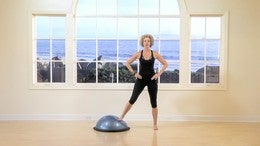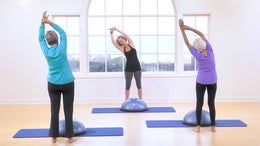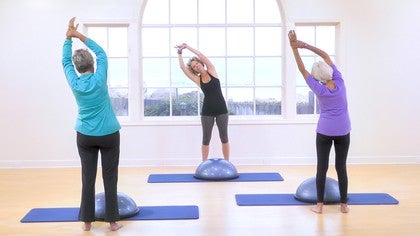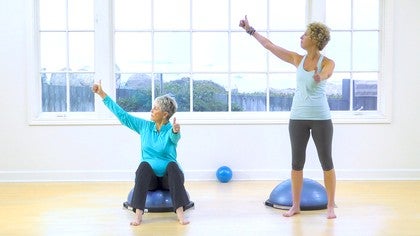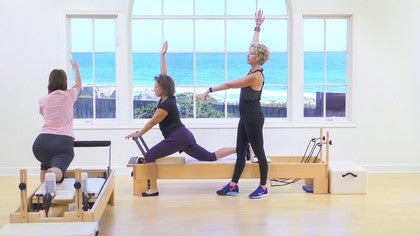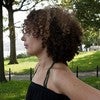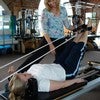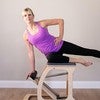Description
About This Video
Transcript
Read Full Transcript
You're in for a treat as active agers. It is critical and very important to train balance in all six types of body positions. I'm here with, my mom is 74 years young because the term senior is out and the term active ager is in. I'm so proud that you're here with me today mom and so today we're going to go through six different body positions with the Bosu balance trainer. It offers us a lay bile surface to work with. Now if you don't have one of these at home, that's perfectly fine, especially for this first drill that we're going to begin shortly with.
You could just use a round surface area in front of you or if you have a balance disc or something with a more lay bile surface in front of you. That's great. One of the things I want to mention with these six different body positions, training balance, we really need to do this for fall prevention, for reaction time, for better activities of daily life and also to improve on a sense the science of aging and four out of five types of aging can be improved. The only one type of aging, sorry mom, that can't be improved upon is our chronological age. So I will be 40 years young or I am 40 years young, she is 74 years young and she will not be 73 years young and I will not be 39 years young. We can certainly pretend but it's not going to happen. So one last thing to remember as an active age or is that we are not exercising, we are playing games because neuroplasticity is very important to train brain and balance to really get that brain active and working and the neuromuscular patterns firing to again improve on activities of daily life.
You want to stay living in your house as long as possible and I want that for you. So let's start with the clock drill. Are you right? Ready? This is a reaction game. So this is all about thinking and reacting. So the Bosu balance trainer is a clock and we're standing at the back of our balance trainer at six o'clock so 12 o'clock is at the front, three o'clock is to the right and six o'clock is to the left. So from here we're gonna go right foot, two o'clock [inaudible] good left foot. Six o'clock it's okay. Left foot. Six o'clock, good left foot. Six o'clock. Good left foot.
Nine o'clock right foot, three o'clock left foot, 12 o'clock. Good. Left foot, seven 30 also important to touch with your heel to get that anterior tibialis activated in the Dorsal flexor of the foot for fall prevention and gait training. Right? We don't want shuffling along the floor. We want you to be present in up as you're and pay attention to what my mom's doing as you're going through this drill with her. Because sometimes you might need to look down and sometimes you might feel better and more confident and you can look up. So I say to you, look down as much as you need, but as little as possible because we are moving through life and so we want to move out of fear and into life. So that's our first drill in standing.
So we didn't even stand on the label surface and we were still training, balance and gait and proprioception and reaction time. We're going to now move into safe kneeling. So come back around the side of your dome. You're going to be facing your dome step a little bit further forward. Your feet are about hip distance apart, right, right underneath those hips.
And we're going to get down into a safe kneeling position. This balance trainer has brought us about 11 inches higher from the floor. So the floor comes to us and it gives us comfort for our knees. So take your hands onto your thighs, bend the knees down, slide the hands. Now from here, reach forward onto the dome and slowly lower your knees down.
Now you may need to make micro adjustments here and that's totally fine. We want you to find your sweet spot on the Bosu balance trainer. So from here, if you want less stability, you keep your hands on the surface area of the dome. If you want more stability, which I'm going to ask you to choose, put your hands down onto the floor. We begin training, balance and spinal mobility in the quadriped head position by lifting your right heel up to your tush and beginning to rotate around the knee. So she's going to wag her tail. This is called tail wag.
And notice how when you wag out, you look to your foot as if you have a little tail on and you wag to the left. You look the other direction. Try the other side. Notice how each side might feel entirely different and that's completely fine because we're not made by Mattel even though our parts might be easier to fix. So seeing what's different from side to side, getting quadriped head balance. Good. Give that a rest. And now we're going to move into windshield wiper.
So adjust your knees as you need to because you may have moved depending on the clothing that you're wearing. And now we go into a long lever, the legs extend straight back behind and then you open the leg out and you bring it back to the midline. Now this is going to be different depending on what your range of motion and your mobility is. And that's okay. There's no judgment in balanced training. And Go ahead and try the other leg and see if there's anything different. Still allowing for the mobilization of the spine, that rotation of the cervical spine, and making sure that you're doing it at a bit of a slower pace to accommodate for the vistibular fluid. Great. How are you feeling? Good. Great. So we're going to move into that seated position.
So go ahead and bring your hands back onto the dome. Come in front of the Bosu balance trainer and have a seat on top of it facing this direction. [inaudible]. Good. So come on up to standing. Great. I now best way to get down is to make sure that you have something back behind you. It's there, right? Maybe take a little mini step forward. Great. Slide your hand down your hips, reach your arms forward and go ahead and take a seat down onto the dome. Good, you did great. So from here we're going to move into a visual aspect drills.
So walk your feet a little bit wider, take your thumbs up. Good. So this is called thumbs up. And from here you're going to take your right thumb up into the right and look at that thumb changing rotation of the spine. And come back and notice what might be happening to your body on that surface area. Then you're going to come up into the left, Huh? Good. Nice job. And then I want you to go down into the right and looking down slightly and bring it back up and then go down into the left and bring it back up.
Great. Relax your arms down by your sides. We move into the next position to train balance, which is going to be sidelined. So slide on over to the side. The hips can come all the way down onto the floor and I want you to use the surface area here to kind of cuddle your side body onto it. Your neck is going to want to have support. So if that is necessary for you, just cradle your neck and your hand.
The hips are down in a nice stable position. The top arm reaches forward and you're just going to do some rolling back. So you're going to lift that arm up and roll back. Uh Huh. And then you roll all the way back up and over. So again, we're going for mobility of the spine here and we're using that top arm to do so. Now this just feels really nice. You could add in a circle if you wanted to or you could just stay doing this and you'll notice how your eye gaze has to shift up. And again, you're challenging your visual aspect here to challenge this.
You want to take your top foot and stagger it over your bottom foot, bend your knees up towards you deeper, pull your knees towards the Dome more good. And from here you're going to just lift the hips. Even if it's just a micro micro bit holding that position, you continue with that same arm rolling back position and coming back over. And you don't have to do a thousand of these, just a couple to really get that challenge and go ahead and give that arrest. The final and sixth, the body position that we need to train balance is prone.
And we're going to do, again, some stability as well as mobility here. This ball is going to come in so that you can rest your head on top of it. So you'll be on your belly noticing that nice comfortable position of the belly on the dome. And again, meaning you're going to have to make micro adjustments for your body length. Now the head is on this ball because now the head is in line with the spine, which is exactly what we want as active agers. We don't really want the head above or below the heart.
From here the head stays down and I want you to just lift the arms up into that goalpost position. Great. Super lower the arms back down. So stability of the spine and lift those arms back up. Great. So now that you're here, can you lift your head off of the ball? Lifting up with the middle back muscles. Good. Lower back down with the forehead and lower the arms to the floor, protecting the lower back by slightly pushing the pubis into that a Bosu dome.
Try that again. Lift the arms up first, then elevate good. Then lower the forehead back down and lower the arms. And I just mentioned that we did the sixth body position, but I was joking because we forgot to do supported, supine inclined. So let's do that now. So I want you to go ahead and come off of the dome. You're going to come over here, turn around and you're going to be resting your head on the dome. So turn, just turn around, stay on the floor. Oh yes.
And you're on your back. So now we've achieved this beautiful supported, supine inclined position. And might I add, I was just queuing us through efficient transitions. I put this in a little bit earlier, but we're just doing it at the end. There's no really need to do it in a particular order, but as long as you're getting all six of the body positions in, what you want to make sure is that there's no stress on the neck. So come up a little bit higher on the Bosu balance trainer. And again, note that there might need to be some micro-adjustments for you and the feet are hip distance apart. And now this is a great way to train gate. Get activation through the back line of the body, the hamstrings, and the gluteals by doing some safe bridging.
So lift the pelvis up good and lower it back down. Now I want you to move up a little bit higher on the dome. Good. Try that again. Lift the pelvis up. Good pressure through the palms of the hands. Offers more stability holds. Here we go into some hip dips.
So you're going to drop one hip down towards the floor, bring it back up, drop the other hip down and bring it back up. And notice what's happening in your body as you're doing this. It feels very different from a biofeedback standpoint when you have the head on a lay bile surface, right? So we're still training balance. Go ahead and lower the hips down and take a break. Now to make that more challenging, you could lose a contact point, right?
You could lift one arm, you could lift both arms, and after you've come to a floor position, it's important to take some time to make sure that you cool down and take the time to systemically cool down before you come all the way back up to standing. So mom, I'm gonna have you turn and face the camera or face forward and just lie down onto your side, over the dome exactly. And support your head with your hand and go ahead and take a little rest. So this is just a nice way to end things just to kind of bring the blood back into the parts where they need to go. But more than anything, it's just important as active agers that we really take a look at opportunities to train, balance of really challenging our, um, our appropriate receptor's, improving neuroplasticity, challenging the brain, and helping with fall prevention and reaction time for better activities of daily life. Longterm. Thank you very much.
The Teacher's Corner: Working on Neuroplasticity
Comments
You need to be a subscriber to post a comment.
Please Log In or Create an Account to start your free trial.
